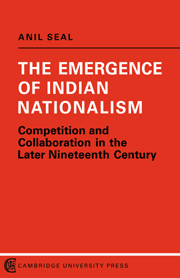Book contents
- Frontmatter
- Contents
- List of Maps and Tables
- Preface
- Abbreviations
- India: British Provinces and Native States
- 1 Political India
- 2 The Political Arithmetic of the Presidencies
- 3 The Rewards of Education
- 4 The Policies of the Rulers
- 5 The Politics of the Associations
- 6 The Politics of Union
- 7 The Muslim Breakaway
- 8 Perspectives
- Appendices
- Glossary
- Biographical Notes
- Bibliography
- Index
5 - The Politics of the Associations
Published online by Cambridge University Press: 23 November 2009
- Frontmatter
- Contents
- List of Maps and Tables
- Preface
- Abbreviations
- India: British Provinces and Native States
- 1 Political India
- 2 The Political Arithmetic of the Presidencies
- 3 The Rewards of Education
- 4 The Policies of the Rulers
- 5 The Politics of the Associations
- 6 The Politics of Union
- 7 The Muslim Breakaway
- 8 Perspectives
- Appendices
- Glossary
- Biographical Notes
- Bibliography
- Index
Summary
Associations brought nineteenth-century India across the threshold of modern politics. Sometimes religious zeal, sometimes caste solidarity encouraged the propensity towards associations, but during the course of the century more of the associations in India were brought into being by groups of men united by secular interests. What now held them together were common skills and functions, a common education, and common aspirations and resentments against the policies of the Raj, not simply the bonds of joint family, caste and district. There was a time when these would have been the only points of union; but now that this was no longer so, Indians were converging on modern politics.
There are some qualifications to the starkness of this formulation. Associations were not new in India. From one point of view, were not all castes forms of associations? Functionally they were; but the rigidities of endogamous caste systems set them apart from the new unions based on successful adaptation to the demands of a new regime, with its very different viewpoints and novel pressures. A second qualification is that extended patriotisms were not unknown in India, as the history of the Sikhs or the Marathas shows. Thirdly, the new associations of professional men did not at once liquidate the old unities of caste, joint family and district. Indeed, they are still of profound importance today. Some of the associations did, however, provide a method of going beyond them. They may be defined in Hobbesian terms as corporations, whose function was to keep themselves as independent entities under the cover of the regime.
- Type
- Chapter
- Information
- The Emergence of Indian NationalismCompetition and Collaboration in the Later Nineteenth Century, pp. 194 - 244Publisher: Cambridge University PressPrint publication year: 1968
- 1
- Cited by

